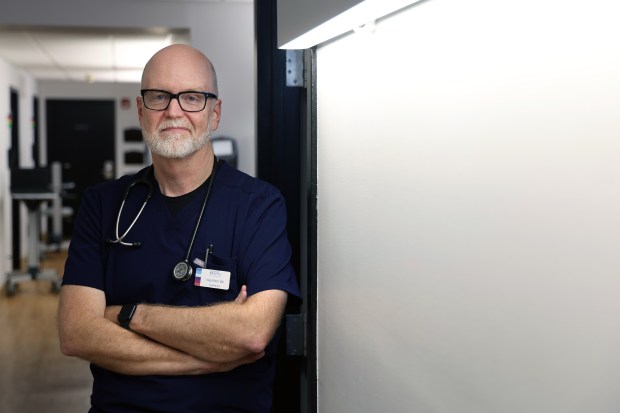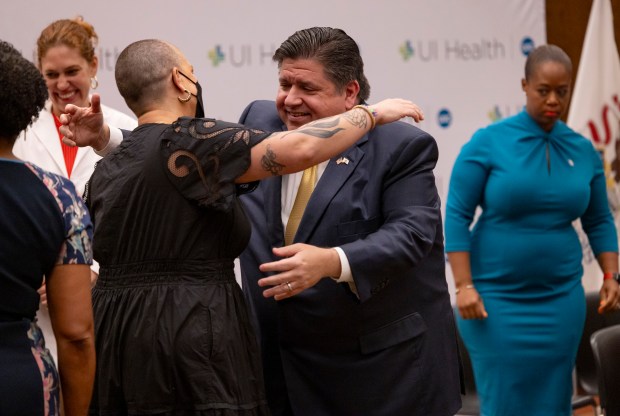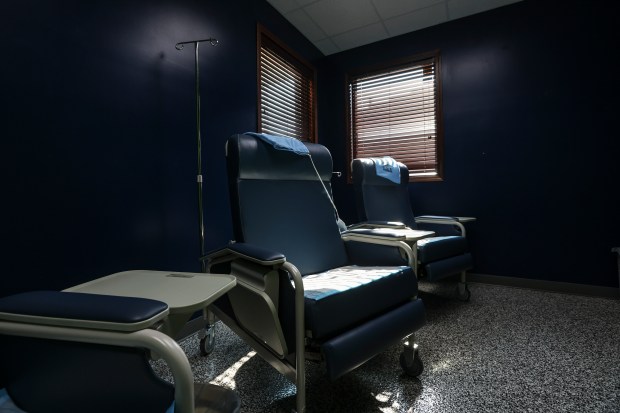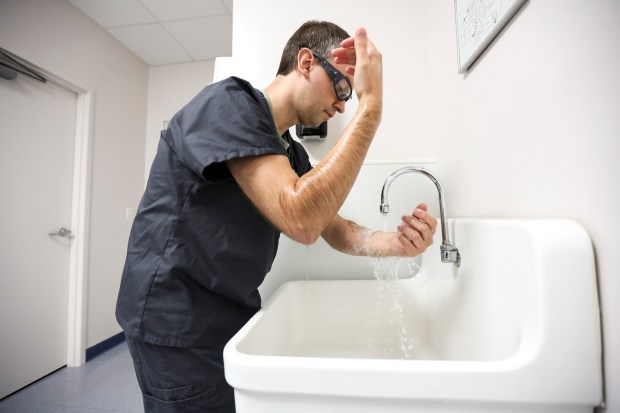Obstetrics and gynecology resident Dr. Cory Reiter travels more than 200 miles round trip from Indianapolis to an Illinois clinic once a week to learn how to perform abortions, which she deems a vital aspect of health care.
Yet opportunities for learning how to terminate a pregnancy have dwindled in Indiana since the state’s near-total abortion ban went into effect in August, spurring Reiter and other OB-GYN residents at Indiana University School of Medicine to come to Illinois for abortion training.
“This is something that is life-saving care,” said Reiter, whose residency program did not want to name the Illinois clinic where she’s training. “I’ve seen mothers become very ill. I have seen people who are forced to remain pregnant who do not want to remain pregnant. I’ve witnessed firsthand how this kind of care is important both to women and their families.”
As the two-year anniversary of the demise of Roe v. Wade approaches, an increasing number of medical providers around the country are crossing state lines — including into Illinois — for comprehensive abortion training as large sections of the nation either ban or severely restrict pregnancy termination.
Since U.S Supreme Court case Dobbs v. Jackson Women’s Health Organization ended federal abortion rights on June 24, 2022, 14 states have enacted abortion bans and several others restricted termination to very early gestation limits, according to the Guttmacher Institute, a research group that supports abortion rights.
When abortion access dries up due to bans and restrictions, so do abortion training opportunities for medical providers. Many reproductive rights advocates fear the dearth of abortion training in large portions of the country will have severe long-term consequences on the quality of the nation’s medical care, from exacerbating health care deserts to worsening the existing United States maternal mortality crisis.
“Compared to states where abortion is accessible, states that have banned, are planning to ban, or have otherwise restricted abortion have fewer maternity care providers; more maternity care ‘deserts;’ higher rates of maternal mortality and infant death, especially among women of color; higher overall death rates for women of reproductive age; and greater racial inequities across their health care systems,” states a December 2022 report by the Commonwealth Fund, a nonprofit private foundation that studies health care issues.
However, some physicians who are opposed to abortion disagree that a void of elective abortion training will impact the safety or quality of health care.
“It’s sort of a fallacy that most OB-GYNs trained anywhere aren’t equipped to do the procedures necessary in terminations,” said Dr. Karen Deighan, an OB-GYN who practiced and trained other physicians for more than 30 years before retiring in July from Loyola University Medical Center, a Catholic institution. “It’s a little bit, to me, scare tactics. Because every time I read that I think ‘I know how to do an abortion, that doesn’t mean I will do one.’”
Deighan, who was a featured speaker at March for Life Chicago in 2020, noted that medically, the treatment for an abortion and miscarriage are essentially the same. She added that she believes most abortions are antithetical to the role of a physician.
“I still believe life begins at conception and I still believe an elective termination is taking a life,” she said. “I do believe in the sanctity of life, and the elective termination of pregnancy is not what we’re called to do as physicians who heal.”
‘Oath to protect patients’
State abortion bans or restrictions impact the training of an estimated 44% of obstetrics and gynecology residents nationwide.
As of June 1, more than 1,250 obstetrics and gynecology residents and 56 residency programs are in states with abortion bans, and more than 500 obstetrics and gynecology residents and another roughly two-dozen residency programs are in states that restrict abortion to six weeks gestation, according to an analysis by the Kenneth J. Ryan Residency Training Program at the Bixby Center for Global Reproductive Health.
Obstetrics and gynecology residency programs are still required to provide abortion training, although residents with a moral or religious objection are allowed to opt-out. Programs in parts of the country with bans or restrictions “must provide access to this clinical experience in a jurisdiction where no such legal restriction is present,” states the Accreditation Council for Graduate Medical Education.
“Such training is directly relevant to preserving the life and health of pregnant patients in some instances and equips residents with the skills and knowledge necessary for providing care in other reproductive health care contexts,” the council concludes in its requirements.
The post-Dobbs reproductive rights landscape has left much of the abortion training burden on states such as Illinois, which has strong reproductive freedoms.
Since the end of Roe, Planned Parenthood of Illinois has seen a roughly 60% increase in trainees at its clinics, with many traveling here from other states.
“There’s a big-time increase in demand for training,” said Dr. Virgil Reid, associate medical director with Planned Parenthood of Illinois. “We have recently reached a point where we had to put a pause on saying yes to new training requests from universities and other organizations around the country that frankly are desperate to get their doctors — their residents — training in this work.”

The Illinois Department of Public Health in April awarded a $2 million grant to Planned Parenthood of Illinois and two other organizations — the Chicago-based Midwest Access Project and the University of Illinois Chicago College of Nursing — to increase abortion training statewide, citing the steep rise in need following the Dobbs decision.
The grant marks a “first-of-its-kind in Illinois state-funded training effort” in response to the rise in need following the Dobbs decision, according to a health department statement.
“When I said Illinois would be an oasis for women seeking reproductive care, I meant it,” Gov. J.B. Pritzker said in the statement, adding that the grant will “help offer health care providers — who are meeting the moment with compassion and service — access to the training and mentorship they need to deliver the care women deserve.”
For Reiter, the OB-GYN resident from Indiana, traveling out of state once a week is an added challenge on top of the already grueling work of residency.
Yet she believes abortion skills are a “professional, moral and ethical obligation.”

Her school’s residency program had to secure training opportunities in Illinois for 10 OB-GYN residents each year, get them licensed in Illinois and fund their travel. The cost to the university has been an additional $20,000 annually, said Dr. Nicole Scott, director of the school’s OB-GYN residency training program.
“Abortion training is really more than just understanding the skills and competency of doing an actual procedure,” Scott said. “It’s about understanding how to deliver bad news. It’s understanding how to obtain informed consent. It is ultrasound training. It is procedural training. It is management of complications. It is developing shared decision-making with the patient. It is empathy and communication. And so while you can still get that in other realms of OB-GYN, abortion care is unique in how all of those things are provided and learned.”
The day the Supreme Court reversed Roe, Reiter felt “emotionally upset but highly motivated” to provide high-quality abortion care, she recalled.
“I took an oath to protect patients,” she added. “And I am being told by someone who is not qualified to make that decision for the patient that I am not allowed to perform or fulfill my ethical responsibilities.”
Patient and provider: parallel travel
During the spring, 39-year-old Bobbi Bryant of Indianapolis spent three months training in abortion care at Equity Clinic in Champaign.
The registered nurse, who is studying to become an advance practice nurse, had rented a house in Illinois for roughly $7,000, an out of pocket expense.
But she felt compelled to learn how to provide abortions after the Dobbs decision, which came as a shock to her despite the rise in state abortion restrictions and other warning signs leading up to the Supreme Court reversal on Roe.
“This is the law of the land, it’s not going to change,” she had always thought to herself.
Equity Clinic is among a slew of new clinics that have opened in Illinois following the overturning of Roe. It was founded in February 2023 by Dr. Keith Reisinger-Kindle, who used to drive roughly 500 miles round trip from Ohio to provide abortions there until he and his family moved to Illinois in November.

Abortion training has been a cornerstone of Reisinger-Kindle’s mission, to help foster the next generation of abortion providers.
“I want good OB-GYNs working in the world and so I want to be able to provide them with the skill sets to do this,” he said. “It is not lost on anybody that places that have abortion bans or severe restrictions on care also have the highest (maternal) mortality rates in the country. That is not a coincidence. It is part of the bigger puzzle. It can only hurt that folks don’t have exposure to this.”
The clinic has provided training for 10 learners so far, mostly a mix of medical students and residents, who train in two-to-four-week rotations. Bryant was the first advanced practice nursing student to train there.
Nine of those who trained at Equity Clinic traveled from other states, including Indiana, Texas and Ohio.
More than 90% of Equity Clinic’s patients are from out of state as well, Reisinger-Kindle said. The year Roe fell, nearly 17,000 patients came from other states to terminate a pregnancy in Illinois, a 49% increase over the previous year.

The parallel travel was a bit ironic to Bryant, who recalled helping treat many fellow Hoosiers who came to the Illinois clinic from places far closer to her home.
“When I would say, ‘I’m from Indiana too,’ in a way, they felt not alone,” she said.
One patient drove some 600 miles from Alabama by herself and, once she arrived, “just started bawling,” Bryant recalled.
Before the abortion, the patient was offered various contraception options but declined, saying that birth control was against her religion.
“Just that level of torture internally, it makes me sad,” Bryant said. “But then you’re sending someone home who might need (an abortion) again. And then would have to drive all the way from Alabama to Illinois all over again. It’s just cyclical trauma.”
Next generation of providers
While Bryant intends to continue living in Indiana, she believes that she’ll eventually work in Illinois, either part-time or full-time, because she believes abortion care is her calling.
Last year, Illinois passed legislation to widen the pool of abortion providers in response to the crush of out-of-state patients arriving post-Dobbs, including provisions that allowed advanced practice nurses and physician assistants to perform some abortion procedures.
Bryant recounted her own medication abortion years ago in Indiana at 19, after a family friend forced her to have unprotected sex with him and she became pregnant, she said.
For many years, she kept the abortion a secret from her family and conservative community.
“I didn’t have somebody I could confide in … and I wish I can be that for other people,” she said. “And let them know that abortion is OK. Abortion is normal. Abortion is health care.”
Many reproductive rights proponents worry abortion restrictions post-Dobbs are driving away physicians and other medical providers from states with bans or early gestation limits.
There’s already some evidence that abortion restrictions might be impacting physicians’ decision on where to train: After the fall of Roe, students graduating from medical schools in the United States were less likely to apply for residency positions in states with abortion bans and severe restrictions, according to an analysis by the Association of American Medical Colleges released in May.
“Continued disproportionate decreases in the number of applicants to programs in states with (abortion) limits or restrictions were observed across all (medical) specialties in aggregate,” the researchers found.
But Dr. Susan Bane, board member of the American Association of Pro-Life OB-GYNs, cautioned against using these statistics “to fuel oversimplified political narratives.”
“For one, those who blame abortion laws for the decline in residency applications are overlooking the fact that the difference in the magnitude of the decline between pro-life and pro-choice states is small and has not been assessed for statistical significance,” she said. “Furthermore, correlation does not imply causation, and the study does not determine whether states’ abortion laws did in fact play a role in medical students’ decisions on where to apply for residency.”
Bane added that “there is no evidence that the decline in residency applications in pro-life states is translating into a shortage of physicians training in those states,” noting that the study also found that nearly all obstetrics and gynecology residency positions across states were filled this year; residencies for most other large medical specialties also filled at rates similar to previous years.
As for the states where abortion is legal, many clinics have been grappling with a surge in patients and have less capacity for training, said Latona Giwa, executive director of Midwest Access Project, a Chicago-based nonprofit that helps fill gaps in sexual and reproductive health education and clinical training nationwide.
Students, residents and medical providers can apply to the Midwest Access Project for training opportunities at clinical sites across the country in the areas of abortion care, miscarriage management, contraception or pregnancy options counseling.
In 2022, in anticipation of the end of Roe, applications skyrocketed by about 300%, Giwa said. The number of applications has increased every cycle since then, she added.
“We accept as many as we can,” she said. “Unfortunately, the percentage has gone down post-Dobbs.”
Clinics are treating so many more patients whose needs are more complicated and challenging because they’ve had to wait longer and traveled farther, Giwa said. Some providers are declining trainees, so it takes longer and more attempts to coordinate a training rotation. Often trainees also need to travel farther and stay longer, which can increase the costs and logistics of training, she added.
“So the whole process is overburdened now,” she said.
Giwa noted that a lot of organizations like hers are ramping up capacity and developing more clinical sites and trainers.
“The one good thing about this moment is there is a lot of will now to address the problem,” Giwa said. “Folks are recognizing that we will not have a next generation of care providers if we don’t act.”
But she believes the strain on abortion care training in the United States “will get worse before it gets better.”
“The pace at which bans and restrictions are proliferating in this country is currently outpacing those efforts,” she said.
eleventis@chicagotribune.com





